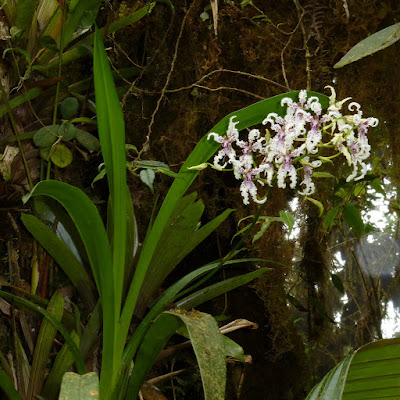Cyrtochilum ramosissimum is native to Venezuela, Colombia and Ecuador. The are widely distributed in south-western parts of South America, from the Andes in western Venezuela...
Cyrtochilum ramosissimum also called as The Many Branched Cyrtochilum, Cyrtochilum ramosissimum f. albomaculatum, Cyrtochilum ramosissimum f. xanthinum, Odontoglossum amphiglottii, Odontoglossum liliiflorum, Odontoglossum ramosissimum, Odontoglossum ramosissimum f. albomaculatum, Odontoglossum ramosissimum f. xanthinum, Odontoglossum ramosissimum var. coeleste, Odontoglossum ramosissimum var. liliiflorum, Odontoglossum ramosissimum var. xanthinum, Oncidium ramosissimum, is a species of the genus Cyrtochilum. This species was described by Stig Dalström in 2001.
IDENTIFY CYRTOCHILUM RAMOSISSIMUM
Cyrtochilum ramosissimum is native to Venezuela, Colombia and Ecuador. The are widely distributed in south-western parts of South America, from the Andes in western Venezuela, through the eastern, western and central branches of the Colombian Andes to the mountains of Ecuador, almost to the Peruvian border. They grow on trees in mountain, damp forests in bright, open locations and on the ground surface near roads, as well as on the edges of forests, at heights of 2200-3600 m.
It is a small sized, cold growing epiphyte or terrestrial, which reaching a height of 69 cm, with closely set, ovate, laterally flattened, 8 cm long and 5 cm wide pseudobulbs enveloped basally by several distichous, imbricating sheaths with the uppermost few being leaf-bearing and carrying 2 apical, linear-lanceolate, acute, up to 60 cm long and 4 cm wide leaves that are conduplicate towards the base into the petiole.
The Many Branched Cyrtochilum blooms on an axillary, erect, to 70 cm long, paniculate, to 100 flowered inflorescence arising on a newly maturing pseudobulb that can occur at any time of the year and carrying faintly fragrant flowers. The flowers are loosely arranged, they are about 5 cm in diameter. The flakes of both whorls have claws at their bases, their narrowly lance-shaped surfaces narrow on a fairly long section, forming a sharp tip, with very undulating edges and vertices tilted back.
CYRTOCHILUM RAMOSISSIMUM CARE AND CULTURE
Cultural information should only be used as a guide, and should be to be adapted to suit you. Your physical location; where you grow your plants, how much time you have to devote to their care, and many other factors, will need to be taken into account. Only then can you decide on the cultural methods that best suit you and your plants.
Light:
Temperature:
The average temperature of the summer day is 16-18 ° C, night 7 ° C, giving a daily difference of 9-11 ° C. The average temperature of the winter day is 14-16 ° C, the night 4-6 ° C, giving a daily difference of 10 ° C.
Humidity:
The Many Branched Cyrtochilum needs the humidity of almost 80% for most of the year. In the period of 2 months at the end of summer or at the beginning of autumn, it drops to 75%, after which it increases to 85% in the period of 2-3 months at the end of autumn and at the beginning of winter.
Substrate, growing media and repotting:
You can use any loose, fast-drying substrate.
Watering:
Precipitation is moderate to heavy for most of the year, but during the 2 winter months it is slightly lower. The cultivated plants should often be watered during active growth, but excellent drainage should be ensured, and the substrate around the roots should almost dry completely between watering.
Fertilizer:
During the active growth, the plants should be fertilized every week 1/4-1/2 of the recommended dose of fertilizer for orchids.
Rest period:
In winter, Cyrtochilum ramosissimum need less water, especially those grown in a short, dark day at moderate latitudes. However, they should not dry out completely. Fertilization should be reduced or eliminated until spring, when regular watering is undertaken.















COMMENTS